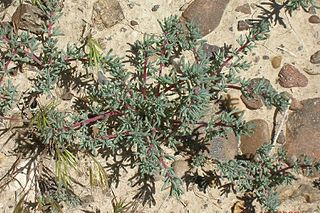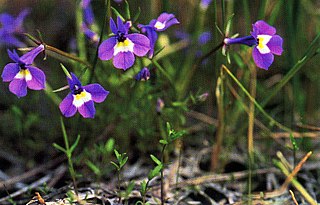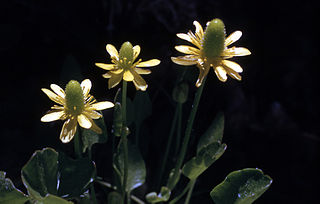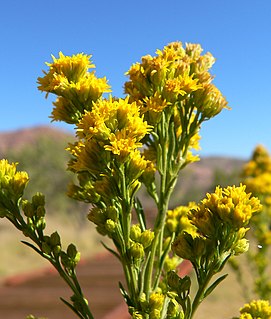
Halogeton glomeratus is a species of flowering plant in the amaranth family known by the common names saltlover, Aral barilla, and halogeton. It is native to Russia, Central Asia and China, but the plant is probably better known in the western United States, where it is an introduced species and a notorious noxious weed. This annual herb is a hardy halophyte, thriving in soils far too saline to support many other plants. It also grows in alkali soils such as those on alkali flats and disturbed, barren habitat. It can be found in sagebrush and shadscale habitat, and it grows well in areas with cold winters.

Calochortus striatus, known by the common name alkali mariposa lily, is a species of mariposa lily native to California and into Nevada.

Cleomella is a small genus of about ten species of flowering plants. Like their relatives, the cleomes, plants of this genus have traditionally been included in the caper family Capparaceae but have recently been moved into a new family, Cleomaceae. Cleomella are annual wildflowers native to the dry and desert regions of western North America. They are similar to cleomes in appearance. They are erect and branching with leaves divided into three leaflets and inflorescences of yellow flowers with long stamens. Cleomella species are known commonly as stinkweeds or simply cleomellas.

Cusickiella is a small genus containing two species of plants in the mustard family which are native to the western United States. These are mat-forming perennials with a stumpy, branching caudex covered in rounded clusters of tiny, thick leaves. A short stem bears white or yellowish flowers that yield silicles.

Downingia bicornuta is a species of flowering plant in the bellflower family known by the common name doublehorn calicoflower. This showy wildflower is native to the western United States from California to Idaho, where it is a resident of lakesides and vernal pool ecosystems. This annual grows on a branching erect stem with small leaves at intervals. At the top of each stem branch is one or more flowers, each between one and two centimeters wide. The flower has two long, narrow, pointed upper lobes which may be blue or purple. The three lower lobes are fused into one three-lobed surface, which is blue or purple with two bright yellow blotches rimmed with white in the center. The mouth of the flower tube is surrounded by knobby projections of the sepals. The fruit is a dehiscent capsule three to seven centimeters long.
Eryngium articulatum is a species of flowering plant in the carrot family known by the common names beethistle and jointed coyote thistle. This plant is native to the northwestern United States from California to Idaho, where it is a plant of marshes and riverbanks. This is a sturdy, branching perennial herb with rounded, naked stems reaching maximum heights over one meter. It has a few sparse sharply serrated leaves at nodes and branching points along its stem. Atop the stem is the rounded to egg-shaped flower head, which looks superficially like that of a thistle, mainly due to its spikiness and lavender color. It is fringed with up to 17 spiny, toothed, pointed bracts, each up to about two centimeters long. Each flower head is packed full of small lavender flowers.

Isocoma acradenia is a North American species of flowering plant in the daisy family known by the common name alkali goldenbush.

Krascheninnikovia lanata is a species of flowering plant in the amaranth family (Amaranthaceae), known by the common name winterfat. It is native to much of western North America: from central Western Canada; through the Western United States; to northern Mexico.
Lasthenia chrysantha is a species of flowering plant in the daisy family known by the common name alkalisink goldfields. It is endemic to the California Central Valley, where it grows in vernal pools and alkali flats.

Cirsium scariosum is a species of thistle known by the common names meadow thistle, elk thistle and dwarf thistle. It is native to much of western North America from Alberta and British Columbia south to Baja California. There are also isolated populations on the Canadian Atlantic Coast, on the Mingan Archipelago in Québec.

Cleome platycarpa is a species of flowering plant in the cleome family known by the common names golden bee plant and golden spiderflower. It is native to the western United States from northeastern California to Idaho, including the Modoc Plateau, where it grows on clay and volcanic soils in the sagebrush. It is an annual herb branching at the base into several erect stems up to about 60 centimeters tall. The stems are green tinted with purple, coated densely in glandular hairs, and lined with many leaves. Each leaf is divided into three small leaflets. The top of each stem is occupied by a raceme of many flowers. Each flower has generally four yellow sepals and four yellow petals around a center of many yellow stamens. The fruit is a flat, hairy capsule up to 2.5 centimeters long which hangs on the long, remaining flower receptacle.
Cleomella brevipes is a species of flowering plant in the cleome family known by the common name shortstalk stinkweed. It is native to the Mojave Desert and adjacent hills, where it grows in wet alkaline environments such as mineral-rich desert hot springs. It is an annual herb producing a rough, waxy, red stem up to about 45 centimeters tall. The stem is lined with many small fleshy leaves, each divided into three leaflets. Flowers appear in the leaf axils all along the stem, often all the way down to the base. Each grows at the end of a short, erect pedicel. The flower has four tiny yellow sepals and four tiny yellow petals. The fruit is a somewhat rounded, hanging capsule developing at the end of the remaining flower receptacle.
Cleomella obtusifolia is a species of flowering plant in the cleome family known by the common name Mojave stinkweed. It is native to the Mojave Desert and adjacent hills, where it grows in alkaline soils in the desert scrub. It is an annual herb producing a rough, hairy stem up to 90 centimeters long. The branching stem grows erect when new and then the branches droop to the ground with age, forming a bushy clump or mat. Each leaf is made up of three fleshy oval leaflets. Flowers appear in dense racemes on older stems and solitary in leaf axils on new stems. Each flower has generally four hairy green sepals and four yellow petals grouped together on one side of the involucre. The whiskery yellow stamens protrude up to 1.5 centimeters from the flower. The fruit is a hairy, valved capsule a few millimeters in length. It hangs at the tip of the remaining flower receptacle.
Cleomella parviflora is a species of flowering plant in the cleome family known by the common name slender stinkweed. It is native to eastern California and western Nevada, where it grows in desert and sagebrush scrub in the Mojave Desert and southern parts of the Great Basin. It is an annual herb producing a smooth, hairless, reddish stem up to about 45 centimeters tall. There are a few leaves, each made up of three elongated, fleshy leaflets. Most of the flowers are located in a raceme at the tips of the stem branches, and there may be a few solitary flowers in the axils of the leaves. Each flower has four tiny pale yellow petals, each about 2 millimeters long. The fruit is a lobed, valved capsule which hangs on the tip of the remaining flower receptacle.

Collomia heterophylla is a species of flowering plant in the phlox family known by the common name variableleaf collomia. It is native to western North America from British Columbia to Idaho to central California, where it grows in several types of habitat, including open areas on gravelly mountain slopes. It is a hairy annual herb producing a branching, erect stem. As the common name suggests, the leaves are variable in shape, the lower generally with several toothed lobes and the upper sometimes lacking lobes. The inflorescence is a cluster of flowers emerging from the top of the stem or from the axil of a leaf. It may bear up to 25 flowers, each with star-shaped corolla at the tip of an elongated tube. The corolla lobes are lance-shaped and white to deep pink with white bases.

Ranunculus cymbalaria is a species of buttercup known by the common names alkali buttercup and seaside buttercup. It is native to much of Eurasia and parts of North and South America, where it grows in many types of habitat, especially in moist to wet areas such as marshes, bogs, and moist spring meadows. It is a perennial herb producing several stems a few centimeters to nearly 40 centimeters long. Some are prostrate against the ground and are stolons which root in moist substrate, and some are erect. The leaves are variable in shape, the basal ones with notched or slightly divided leaf blades borne on long petioles, and any upper leaves much reduced in size. The inflorescence bears one or more flowers on erect stalks. The flower has five to eight pale yellow petals, each under a centimeter long. The protruding receptacle at the center of the flower becomes a cylindrical cluster of fruits, each of which is an achene.

Silene bernardina is a species of flowering plant in the pink family known by the common name Palmer's catchfly.

Solidago spectabilis is a species of goldenrod known by the common names Nevada goldenrod, basin goldenrod, and showy goldenrod. It is native to the western United States in the Great Basin and surrounding areas. It is found in California, Arizona, Nevada, Oregon, and Utah. There are historical records saying it once grew in southwestern Idaho, but is now extirpated there.
Deinandra bacigalupii is a rare species of flowering plant in the aster family known by the common names Livermore tarplant and Livermore moonshine. It is endemic to Alameda County, California, where there are only about five known occurrences around Livermore. It grows in open areas with alkali soils, such as alkali sinks and meadows. This plant was previously included within Deinandra increscens ssp. increscens, but it was separated and elevated to species level in 1999.

Mentzelia mollis is a species of flowering plant in the Loasaceae known by the common names soft blazingstar, smooth blazingstar, and smooth stickleaf. It is native to the western United States, where it occurs in Idaho, Oregon, and Nevada.

















